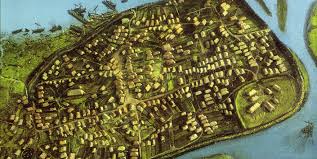The hidden past of Viking Dublin
A few weeks before Christmas, there was published what was among the most important Irish books of last year. This was Patrick Wallace’s Viking Dublin: The Wood Quay Excavations (Irish Academic Press, €60.00 hb), the final magisterial report on archaeological investigations into Viking Dublin, which began in Christ Church Place in the 1960s and continued in the following decades, on the Wood Quay site, where the City Offices now stand.
This was controversial work, not so much for the archaeology, as for the preservation of what was found as a national monument. But when culture conflicts with capitalism, you can be sure that capitalism, with all the talk of building the economy and creating jobs, will win out.
This history of conflict is well known. What this book deals with is what was done by the archaeological teams, what was found, and more importantly, what it all means in the greater perspective, not only of Irish history, but of European, indeed world history. Hence the great importance of the excavations at Wood Quay.
The redevelopment of Dublin provided an opportunity not to be passed up. For centuries of later building, medieval, Georgian, Victorian and modern, had covered over the remoter periods of the city’s history. The discoveries in Viking Dublin revealed the underlying pattern of the city centre laid down at that time, but was not fully realised.
Dublin was shown to be not a provincial town of the recent British Empire, but a place of strategic international importance in earlier times. Viking Dublin, indeed Viking Ireland, was revealed to have cultural tendrils that spread out to the rocky shores of Labrador in the West, in the East to the rivers of Russia and the shore of the Black Sea, and southwards to France and to Sicily, where at the end the culture analysed Norman Europe was already taking shape. (These connections lasted: from Sicily Frederick II of Hohenstaufen, author of The Art of Hunting with Birds, was able to send a mission in the 1230s to the west of Ireland to investigate the myth of the barnacle goose being born from the marine organism.)
This is an important book, and Dr Wallace is to be congratulated for bringing the whole great enterprise, in which so many took part, to such an accomplished conclusion with an attractive and readable book which recalls Max Mallowan’s book on Nimrud and other great classics of archaeology.
But an important book, no matter what answers it provides, will raise new questions about what remains unknown. Archaeology is a science which has never stood still. Some of its results often challenge long held beliefs of historians of ancient times trying to make sense of myths, legends and fragmentary written evidence by providing hard physical facts.
One question in my mind is the Irish penetration of the North Atlantic in early medieval times, which remains obscure. The 12th Century Arab geographer Al-Idrisi in his writings refers airily to Ireland and to “Greater Ireland”, meaning a territory across the Atlantic. Where this was is still unresolved.
Equally interesting is, what was Dublin like before the Vikings? Older readers will recall that Dr George Little (who did so much to popularise the legend of St Brendan) wrote a book called just that – Dublin before the Vikings. His sweeping claims dismayed some of his medievalist friends such as the Jesuit Dr John Ryan, for he imagined an actual city, for which he sketched to an extent that was surprising, but perhaps an illusion.
But something was there, for there were churches, monasteries, settlements, even references to a king. It is an axiom of archaeology that an important site will be found to have been important for far longer than is thought.
Thanks to Leinster’s exposure to invasion and rapine over the centuries, no annals of Dublin or Leinster survive. We simply do not know the kinds of things that we know about the other provinces from the surviving annals. History being unable to answer all the questions about Dublin’s prehistory, only archaeology will be able to do so. Let us hope that future work will prove less contentious, the authorities having absorbed the lessons of Wood Quay.



